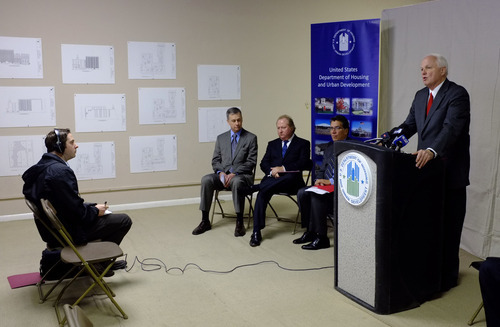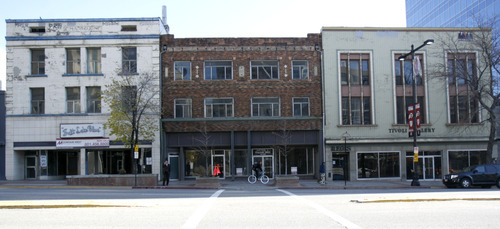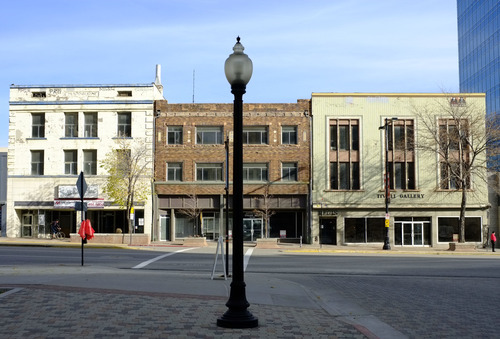This is an archived article that was published on sltrib.com in 2011, and information in the article may be outdated. It is provided only for personal research purposes and may not be reprinted.
A complex federal financing package, made possible in part by President Barack Obama's stimulus, is poised to turn one of downtown Salt Lake City's seediest tenements into a symbol of urban renewal.
The newly dubbed "Plaza at State Street" is the $30 million brainchild of English architect and developer Ben Logue, an affordable-housing expert who spent the 1980s rehabilitating and designing apartments, buildings and theaters in New York's SoHo and upper east side.
Logue's now-funded vision for Utah's capital is to gut the vacant single-room-occupancy slums between 235 and 257 S. State Street — maintaining some of the brick façades — while fashioning 180 mostly affordable-housing units and street-level shops inside the historic properties.
"I'm so excited," Logue said Tuesday as city, state and federal housing officials gathered inside the chilly lobby to announce that the "creative," 12-source funding puzzle is complete. "This is stuff I really like to do."
Demolition will start in January. The energy-efficient plaza is scheduled for completion 15 months later, a year after another, much bigger downtown face-lift debuts: the $2 billion City Creek Center.
"This project … is a celebration of sorts," said Rick Garcia, regional administrator for the U.S. Department of Housing and Urban Development, praising how well federal, state and local dollars were leveraged. "That is an amazing undertaking, particularly in today's development environment."
The blueprint calls for a rebuild of the Regis and Cambridge hotels, with three floors set back 50 feet to maintain the historic façade. The buildings just north, at 235 and 241 S. State St., will be demolished to make way for a 10-story apartment complex — linked to the remade hotels — above boutique shops.
The total project will include 44 units priced at market rates. But 136 "affordable" units will serve low- and moderate-income households. Nearly 40 units will fit large families, five will be fully accessible for special needs, and 10 will be designated as "Housing Opportunities for Persons with AIDS."
There will be studio rentals along with one-, two- and three-bedroom units. Studios will be priced at 35 percent of area median income, while the larger apartments will target residents at 60 percent of area median income.
"With City Creek coming in, people have got to be able to afford to live where they work," said Shad West, of the Utah Division of Housing and Community Development. "That's what's special about this project."
There also will be a blend of seven retail shops and restaurants inside the plaza, two levels of underground parking, and the property's existing Rex Theater will be salvaged and modernized.
Logue, president of The La Porte Group, expects 250 construction jobs followed by 250 permanent ones once the plaza is done. He recently refurbished the Stratford Hotel at 200 South and 200 East — now known by the Second & Second moniker — into affordable housing. A leader in "green" building design, Logue snatched additional tax credits for the plaza by pledging to include solar panels and Energy Star appliances.
In essence, the project is financed through federal tax credits converted to equity along with money from Obama's Neighborhood Stabilization Program. The significant contribution of equity money — which, unlike a loan, does not need to be repaid — covers most of the development tab, allowing rents to remain low.
City Councilman Luke Garrott has long backed the makeover and the property sale to Logue.
"I saw the potential here," he said, "saw the potential of maintaining cultural capital on State Street. What we have is an attempt by various actors in downtown to create a city that is walkable — that people remember from old pictures."
Previous tenants of the Regis and Cambridge studios were moved to Palmer Court and Rio Grande, low-income buildings in the city.
Garcia said the State Street project was selected for federal dollars because of the dedication and creativity of affordable-housing advocates in City Hall, state government and the private sector. HUD's mantra, he noted, is to foster mixed income and stabilize property values.
The Utah Housing Corp. will issue $18.3 million in bonds to provide the construction financing. And the ratio of low-income rooms to those that are regularly priced is roughly 3-to-1.
Logue says builders will use a new "platform system" that allows a new floor to be completed every 10 days. But the city has long insisted the Regis and Cambridge façades facing State Street remain in place.
That pleases Grant Whitaker, president of Utah Housing Corp., who recently returned from Europe impressed by the preservation of older buildings.
"We don't do that so much here," he said. "But here's an opportunity to do that with significant buildings with significant architectural features."
Plaza at State Street
$30 million redevelopment of run-down single-room-occupancy buildings between 235 and 257 S. State St.
180 new units of mostly affordable mixed-use housing and retail space
2 levels of underground parking with street-level shops
15-month construction to begin in January
250 construction jobs and 250 projected permanent jobs
Bulk of project funded through the federal Neighborhood Stabilization Program and tax credits













